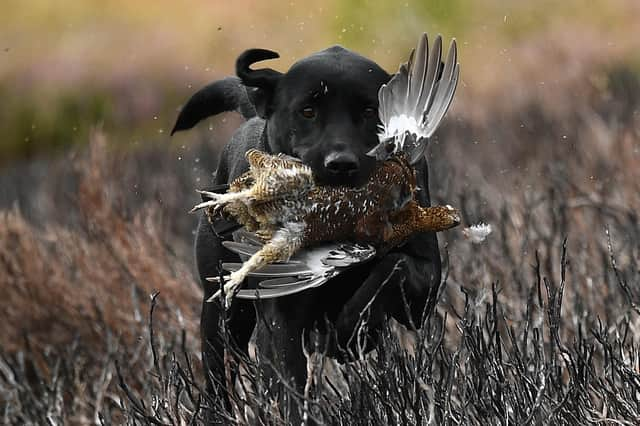Grouse shooting: If it was a new idea, would you support it? – Max Wiszniewski


Today marks the beginning of Scotland’s grouse shooting season – traditionally known as the ‘Glorious Twelfth’ of August – which is now seen as a highly controversial date in the calendar. From now until December 10, many thousands of grouse are legally allowed to be shot by, what will ultimately be, just a few people for sport.
So, what is grouse shooting, why has the killing of this iconic Scottish bird become a past-time amongst some of our societal elites and why is it rightly seen as so completely controversial today?
Advertisement
Hide AdAdvertisement
Hide AdGrouse shooting can take place in more than one form including walked-up shooting but it is driven grouse shooting which is the dominant form and which causes the greatest and most significant societal discord.
Driven grouse shooting is the practice of using a line of ‘beaters’ to drive red grouse over the heads of shooters waiting behind shooting ‘butts’ – who attempt to kill as many of these native birds as possible.
The need for ‘high bag numbers’ on shoot days is what drives a circle of destruction that surrounds the industry, and the intensity of those land management practices has significantly increased since Victorian times when the blood-sport was invented.
Early moorland management involved heather burning to provide an enhanced habitat for breeding and predators were totally eliminated, including many of Scotland’s birds of prey.
This led to a rapid increase in the red grouse population with record numbers of over 2,000 birds killed in a single day. These early days of grouse moor management were accompanied by dramatic fluctuations in grouse numbers due to outbreaks of disease.
In 2022, these management practices largely continue with some important differences in the literal and political landscape. While grouse can be shot for some people’s amusement, birds of prey are now legally protected and recent decades have seen the introduction of high-strength medicated grit stations to combat population fluctuations and the spread of disease that is inevitably present in high densities of grouse.
Grouse ingest mineral grit to assist the digestion of heather, so grouse moor managers provide them with an alternative source of grit, coated with the pharmaceutical worming drug Flubendazole. Some estates, unhappy with the results of using double-strength medicated grit, are now using super-strength medication of up to 20 times the concentration of the original anthelmintic drug, according to a well-known grouse moor manager.
The distribution of a toxic pharmaceutical drug that seeps across the landscape and into the food chain represents a level of intensification that transforms moorland from a semi natural-environment into a quasi-domesticated farmed environment – keeping grouse numbers unnaturally high, for sport shooting. This is far from the wholesome and natural countryside experience that grouse moor managers would have you believe it is.
Advertisement
Hide AdAdvertisement
Hide AdCoinciding with increasingly intensive management practices, while legally protected, it’s the continuing persecution of birds of prey (including golden eagles and hen harriers) that has increased the infamy of the relentless grouse shooting industry.
A 2017 Scottish Government report showed that out of 131 satellite-tagged eagles, about a third had disappeared, presumably died, under suspicious circumstances prompting legislative action that is due in this parliamentary term. Since then, raptor persecution has continued, even amidst a pandemic lockdown.
Grouse moors are due to be licenced by the Scottish Government, which means that if a wildlife crime is committed on a grouse moor then it could lose it’s licence to operate. However, the problems of driven grouse shooting go much further than widespread evidence of illegal activities. The circle of destruction that surrounds grouse shooting even goes beyond the mass chemical medication on our moors.
The muirburn season sees huge swathes of Scotland’s uplands burned, to make the local landscape more suitable for grouse – so more of them can be shot for sport.
This risks the vital peatland that occupies much of our upland moors which emit carbon in a degraded state as opposed to sequestering it. Meanwhile the muirburn monocultures deprive our uplands of a larger mosaic of alternative biodiversity – which would still include heather – keeping the land in a dry and fragile state.
Unregulated bulldozed hill tracks scar the landscape to make life easier for shooters and grouse moor managers. Tons of lead shot is sprayed across the countryside.
Untold thousands of animals like foxes, stoats, weasels and crows still suffer needlessly on grouse moors via snares and traps – just so more grouse can be shot for sport. Does this sound like the modern progressive Scotland we all aspire to?
When the Scottish Government licenses shooting estates, they need to tackle it all. They need to end the entire circle of destruction and get to the heart of the problem – driven grouse shooting. Is the desire of just a few people to shoot more birds justification enough for such damage to our wildlife and the environment? Especially considering the economic returns, to the public at least, are so tiny for all the land it uses up.
Advertisement
Hide AdAdvertisement
Hide AdIf you’re on the fence and you are still to decide whether to support Revive’s reform agenda, then ask yourself the following.
If grouse shooting never existed and large landowners wanted to start it up today – they would make the case for burning the landscape, degrading our peatlands, mass-medicating a supposedly wild bird with high-strength toxic chemicals, killing tens of thousands of other wild animals while spraying grouse with poisonous lead shot for three months, every year – just so more grouse can be shot for sport.
Would you be in, or would you be out?
Max Wiszniewski is campaign manager for Revive, the Coalition for Grouse Moor Reform
Comments
Want to join the conversation? Please or to comment on this article.
